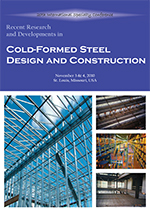Session Dates
03 Nov 2010
Abstract
Cold-formed steel has become a preferred building material for structural framing in many different types of structures, commonly used as repetitive members such as floor joists, roof rafters, roof trusses and wall studs. For wood framed structures with repetitive members, a repetitive member factor increases the allowable bending stress from 1.00 to 1.50 times the reference design value, depending on both the type of material and the type of load. Currently, however, the bending strength of cold-formed steel repetitive members is not permitted to be increased, even though the method of framing is quite similar to that of wood except for the material properties. Typical light-frame wood construction consists of floor, roof , and wall systems, each with repetitive members connected by sheathing. A repetitive system is one of at least three members that are spaced not farther apar t than 24-inches connected by a load distributing element. The behavior of th e individual members, then, is affected by inclusion into this system. The effects of both composite action and load- sharing in a repetitive system increase the bending capacity of bending members. The same general principles of repetitive use should apply to cold- formed steel due to its similarity to wood construction. Based upon a preliminary analytical study of the effects of both composite action and load- sharing in cold-formed steel assemblies it has been concluded that a repetitive member factor for cold-formed steel memb ers is feasible and should be further investigated.
Department(s)
Civil, Architectural and Environmental Engineering
Research Center/Lab(s)
Wei-Wen Yu Center for Cold-Formed Steel Structures
Meeting Name
20th International Specialty Conference on Cold-Formed Steel Structures
Publisher
Missouri University of Science and Technology
Document Version
Final Version
Rights
© 2010 Missouri University of Science and Technology, All rights reserved.
Document Type
Article - Conference proceedings
File Type
text
Language
English
Recommended Citation
Clayton, S. and Stephens, S. F., "Feasibility Study for a Repetitive Member Factor for Cold-formed Steel Framing Systems" (2010). CCFSS Proceedings of International Specialty Conference on Cold-Formed Steel Structures (1971 - 2018). 1.
https://scholarsmine.mst.edu/isccss/20iccfss/20iccfss-session4/1
Feasibility Study for a Repetitive Member Factor for Cold-formed Steel Framing Systems
Cold-formed steel has become a preferred building material for structural framing in many different types of structures, commonly used as repetitive members such as floor joists, roof rafters, roof trusses and wall studs. For wood framed structures with repetitive members, a repetitive member factor increases the allowable bending stress from 1.00 to 1.50 times the reference design value, depending on both the type of material and the type of load. Currently, however, the bending strength of cold-formed steel repetitive members is not permitted to be increased, even though the method of framing is quite similar to that of wood except for the material properties. Typical light-frame wood construction consists of floor, roof , and wall systems, each with repetitive members connected by sheathing. A repetitive system is one of at least three members that are spaced not farther apar t than 24-inches connected by a load distributing element. The behavior of th e individual members, then, is affected by inclusion into this system. The effects of both composite action and load- sharing in a repetitive system increase the bending capacity of bending members. The same general principles of repetitive use should apply to cold- formed steel due to its similarity to wood construction. Based upon a preliminary analytical study of the effects of both composite action and load- sharing in cold-formed steel assemblies it has been concluded that a repetitive member factor for cold-formed steel memb ers is feasible and should be further investigated.



